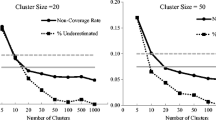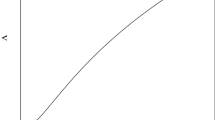Abstract
DeFries-Fulker (DF) Analysis for unselected populations is reformulated as a no-intercept model with centered variables and only two independent variables. The reformulation serves three purposes. First, the original formulation implicitly estimated two different values for c 2 and two values for h 2 . The new formulation resolves this ambiguity. Second, because the original formulation estimated h 2 with the coefficient from a regression-interaction term, whether to center the interaction variables was unclear. The new formulation explicitly resolves this issue. Finally, the new formulation estimates fewer parameters, and therefore improves estimation efficiency and statistical power.
Similar content being viewed by others
References
L. S. Aiken S. G. West (1991) Multiple regression:testing and interpreting interactions Sage Newbury Park, CA
M. Buster J. L. Rodgers (2000) ArticleTitleGenetic and environmental influences on alcohol use: DF analysis of NLSY kinship data J. Biosocial Sci. 32 145–168
K. Christensen O. Basso K. O. Kyvik S. Juul J. Boldsen J. Vaupel J. Olsen (1998) ArticleTitleFecundability of female twins Epidemiology 9 189–192 Occurrence Handle1:STN:280:DyaK1c7msFSnuw%3D%3D Occurrence Handle9504289
S. S. Cherny J. C. DeFries D. W. Fulker (1992) ArticleTitleMultiple regression analysis of twin data: A model-fitting approach Behav. Genet. 22 498–497
S. S. Cherny L. R. Cardon D. W. Fulker J. C. DeFries (1992) ArticleTitleDifferential heritability across levels of cognitive ability Behav. Genet. 22 153–162 Occurrence Handle1:STN:280:DyaK383otFGhtQ%3D%3D Occurrence Handle1596255
L. H. Cyphers K. Phillips D. W. Fulker D. A. Mrazek (1990) ArticleTitleTwin temperament during the transition from infancy to early childhood J. Am. Acad. Child Adolescent Psychiatr. 29 392–397 Occurrence Handle10.1097/00004583-199005000-00010 Occurrence Handle1:STN:280:DyaK3c3ntVagsA%3D%3D
J. DeFries D. Fulker (1985) ArticleTitleMultiple regression analysis of twin data Behav. Genet. 15 467–73 Occurrence Handle1:STN:280:DyaL28%2Fns1yjsw%3D%3D Occurrence Handle4074272
J. DeFries D. Fulker (1988) ArticleTitleMultiple regression analysis of twin data:Etiology of deviant scores versus individual differences Acta Genet. Med. Gemellol (Roma). 37 205–216 Occurrence Handle1:STN:280:DyaL1MzhvFGjtg%3D%3D
L. Hansen (1982) ArticleTitleLarge sample properties of generalized method of moments estimators Econometrica 50 1029–1054 Occurrence Handle0502.62098 Occurrence Handle666123
H.-P. Kohler J. L. Rodgers (1999) ArticleTitleDF Analyses of binary, orderedand censored variables using probit and tobit approaches Behav. Genet. 29 221–232
H.-P. Kohler J. L. Rodgers (2001) ArticleTitleDF-Analysis of heritability with double-entry twin data: Asymptotic standard errors and efficient estimation Behav. Genet. 31 179–192 Occurrence Handle1:STN:280:DC%2BD3MvpslSitg%3D%3D Occurrence Handle11545535
H.-P Kohler J. L. Rodgers K. Christensen (1999) ArticleTitleIs fertility behavior in our genes? Findings from a Danish twin study Popul. Dev. Rev. 25 253–288
H.-P Kohler J. L. Rodgers K. Christensen (2002) ArticleTitleBetween nurture and nature: The shifting determinants of female fertility in Danish twin cohorts Social Biol. 49 218–248
M. C. LaBuda J. C. DeFries (1990) Genetic etiology of reading disability: evidence from a twin study G. T. Pavlidis (Eds) Perspectives on dyslexiaVol. 1 Wiley & Sons New York
R. Plomin (1991) Genetic risk and psychosocial disorders:Links between the normal and abnormal M. Rutter P. Casaer (Eds) Biological risk factors for psychosocial disorders Cambridge University Press CambridgeEngland 101–138
J. L. Rodgers M. Buster D. C. Rowe (2001) ArticleTitleGenetic and environmental influences on delinquency: DF Analysis of NLSY kinship data J. Quantitative Criminol. 17 145–168
J. L. Rodgers H.-P. Kohler K. Kyvik K. Christensen (2000) ArticleTitleBehavior genetic modeling of human fertility: Findings from a contemporary Danish twin study Demography 38 29–42
J. L. Rodgers M. McGue (1994) ArticleTitleA simple algebraic demonstration of the validity of DeFries-Fulker Analysis in unselected samples with multiple kinship levels Behav. Genet. 24 259–262 Occurrence Handle1:STN:280:DyaK2M%2FjtFyltw%3D%3D Occurrence Handle7945155
J. L. Rodgers D. C. Rowe (1987) ArticleTitleIQ similarity in twins, siblings, half-siblings, cousins, and random pairs Intelligence 11 199–206
J. L. Rodgers D. C. Rowe M. Buster (1999) ArticleTitleNaturenurtureand first sexual intercourse in the USA: Fitting behavioral genetic models to NLSY kinship data J. Biosocial Sci. 31 29–41 Occurrence Handle1:STN:280:DyaK1M7otFSktA%3D%3D
J. L. Rodgers D. C. Rowe C. Li (1994) ArticleTitleBeyond nature versus nurture: DF Analysis of nonshared influences on problem behaviors Dev. Psychol. 30 374–384
J. L. Rodgers D. C. Rowe K. May (1994) ArticleTitleDF analysis of NLSY IQ/Achievement data:nonshared environmental influences Intelligence 19 157–177
N. B. Waller (1994) ArticleTitleA DeFries and Fulker regression model for genetic nonadditivity Behav. Genet. 24 149–153 Occurrence Handle1:STN:280:DyaK2c3ps1emsQ%3D%3D Occurrence Handle8024531
Author information
Authors and Affiliations
Corresponding author
Rights and permissions
About this article
Cite this article
Lee Rodgers, J., Kohler, HP. Reformulating and Simplifying the DF Analysis Model. Behav Genet 35, 211–217 (2005). https://doi.org/10.1007/s10519-004-1020-y
Received:
Accepted:
Issue Date:
DOI: https://doi.org/10.1007/s10519-004-1020-y




